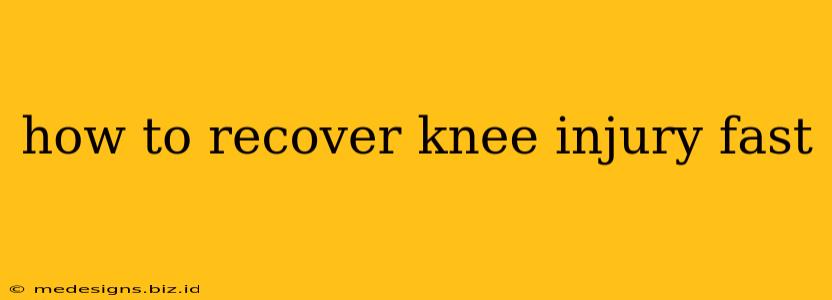Recovering from a knee injury can be a frustrating process, but with the right approach, you can significantly speed up your healing time. This guide provides a comprehensive overview of how to recover from a knee injury fast, focusing on both effective treatment methods and crucial lifestyle changes. Remember, always consult your doctor or physical therapist before starting any new treatment or exercise program. They can diagnose the specific injury and create a personalized recovery plan.
Understanding Your Knee Injury
Before diving into recovery methods, it's essential to understand the nature of your knee injury. Different injuries require different treatments. Common knee injuries include:
- Meniscus Tears: These involve damage to the cartilage in your knee.
- ACL Tears: This refers to a tear in the anterior cruciate ligament, a crucial stabilizer of the knee joint.
- MCL Tears: Involves a tear in the medial collateral ligament, another important knee stabilizer.
- LCL Tears: A tear in the lateral collateral ligament.
- PCL Tears: A tear in the posterior cruciate ligament.
- Patellar Tendinitis (Jumper's Knee): Inflammation of the patellar tendon.
- Runner's Knee (Patellofemoral Pain Syndrome): Pain around the kneecap.
Accelerating Your Knee Injury Recovery: Key Strategies
The key to fast recovery lies in a multi-pronged approach:
1. RICE Method: The Foundation of Initial Treatment
The RICE method is crucial in the immediate aftermath of a knee injury:
- Rest: Avoid activities that aggravate your knee.
- Ice: Apply ice packs for 15-20 minutes at a time, several times a day, to reduce swelling and pain.
- Compression: Use a compression bandage to minimize swelling.
- Elevation: Keep your leg elevated above your heart whenever possible.
2. Medication and Medical Intervention
Your doctor may prescribe medication to manage pain and inflammation, such as:
- Nonsteroidal anti-inflammatory drugs (NSAIDs): Ibuprofen or naproxen.
- Corticosteroids: For severe inflammation.
In some cases, surgery might be necessary, especially for severe ligament tears or meniscus damage.
3. Physical Therapy: The Key to Strengthening and Rehabilitation
Physical therapy plays a vital role in recovery. A physical therapist will create a personalized program focusing on:
- Range of motion exercises: To restore flexibility.
- Strengthening exercises: To rebuild muscle strength around the knee.
- Balance and proprioception exercises: To improve stability and coordination.
Consistency is key with physical therapy. Attend all your sessions and diligently perform your home exercises.
4. Nutrition for Faster Healing
Proper nutrition supports tissue repair and reduces inflammation:
- Protein: Crucial for building and repairing tissues. Include lean meats, fish, beans, and lentils in your diet.
- Anti-inflammatory foods: Fruits, vegetables, and omega-3 fatty acids (found in fish and flaxseed) can help reduce inflammation.
- Hydration: Drink plenty of water to aid in tissue repair.
5. Lifestyle Modifications
Making some lifestyle adjustments can significantly impact your recovery:
- Avoid high-impact activities: Until your knee is fully healed.
- Maintain a healthy weight: Excess weight puts extra stress on your knees.
- Listen to your body: Don't push yourself too hard too soon. Pain is a warning sign.
When to Seek Medical Attention
Seek immediate medical attention if you experience:
- Severe pain.
- Inability to bear weight on your leg.
- Significant swelling or deformity.
- Numbness or tingling in your leg or foot.
The Bottom Line: Patience and Persistence Pay Off
Recovering from a knee injury takes time and patience. By following these strategies and working closely with your healthcare providers, you can significantly improve your chances of a speedy and successful recovery. Remember to prioritize consistency, listen to your body, and celebrate your progress along the way. Your hard work will ultimately lead to a stronger, healthier knee.
